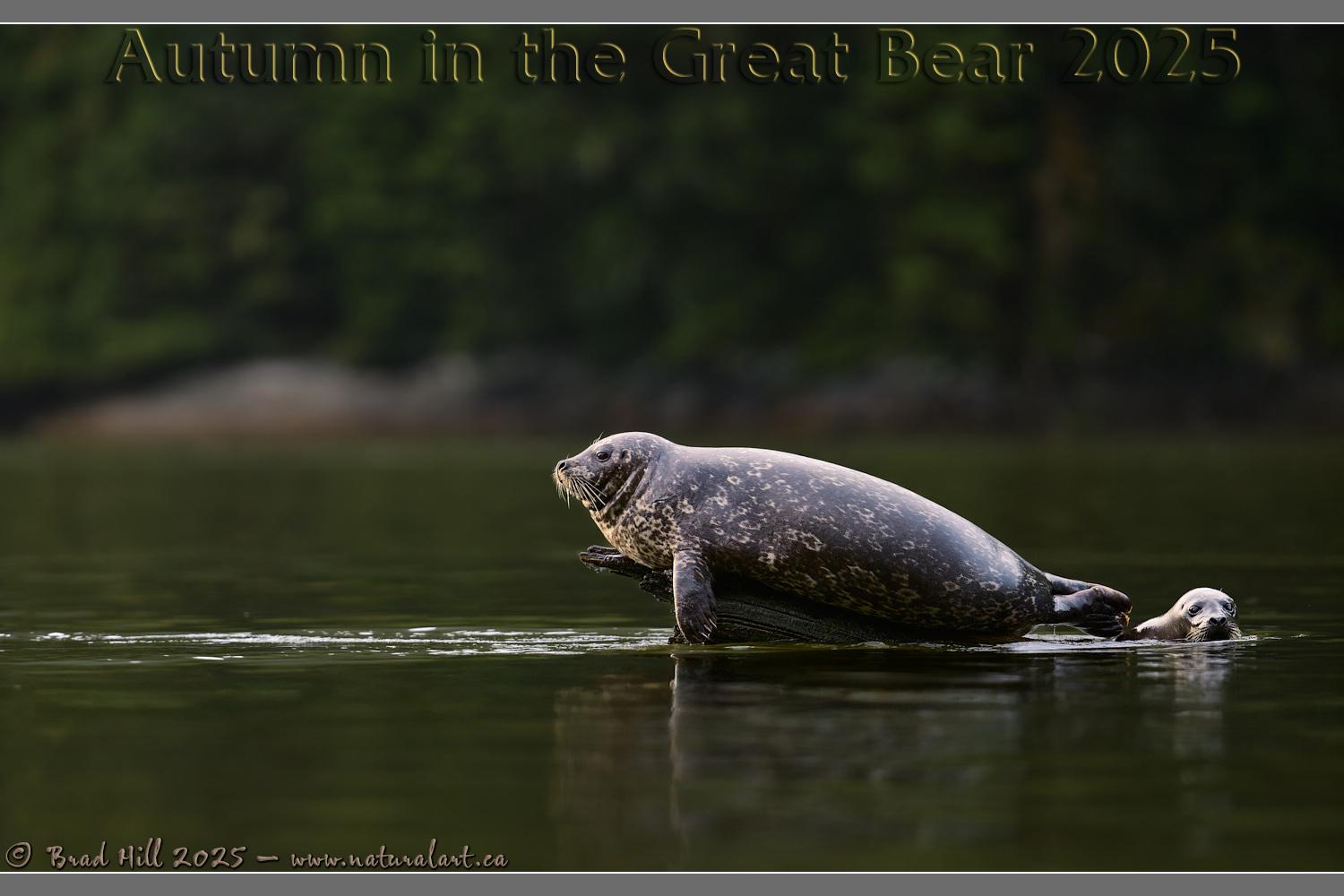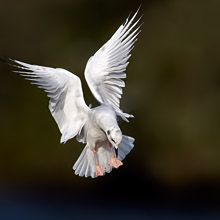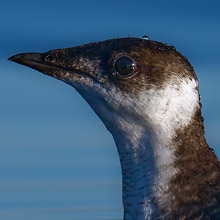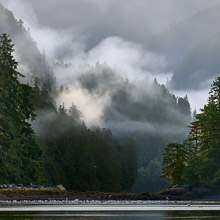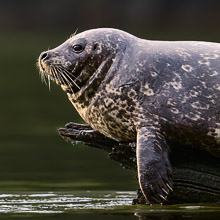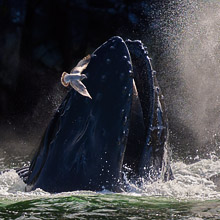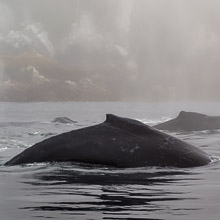Availability: Undetermined - Enquiries?
In the Field
Into the Setting Sun. Great Bear Rainforest, British Columbia, Canada. September 23, 2025.
One of the many things I like about shooting in the Great Bear Rainforest is that there's almost always something to point your camera at. Often our "primary targets" are of the "most charismatic megafauna" variety, including such things as Grizzly Bears, Spirit Bears, coastal Gray Wolves, and Humpback or Killer Whales. But if we're out in the Zodiac in almost any of the major estuaries of the Great Bear and we're temporarily without one of primary targets, there's almost always Harbour Seals to play with! We caught this pair of Harbour Seals just as the sun was going down and they were illuminated with the last golden rays of the day. Watching these two seals jostling for position on the only above-water haul out object in the immediate area was a nice way to end the day.
I captured this image using Sigma's 200mm f2 Sports lens (Sony mount) on my Nikon Z 9 (mounted using a Megadap Pro+ mount adapter). This shot nicely illustrates one of the main reasons I REALLY like the Sigma 200mm f2 - functionally it gives your images that "400mm f2.8 look", but with subjects considerably closer than you'd be able to shoot them with a 400mm lens. Three things contribute to this look - a very nice compression effect owing to the 200mm focal length, razor sharp in-focus areas (edge-to-edge!), and buttery smooth out-of-focus zones. If you like your subject nicely isolated from the background and thus making it absolutely "pop" then this lens is a great option.
You might be thinking "C'mon Brad, how much better subject isolation and subject "pop" do you get with the 200mm f2 compared to shooting the same image wide open with a good 70-200mm f2.8 lens shot at f2.8?" Good question, and I had the same question myself. So I did a bunch of head-to-head tests of the Sigma 200mm f2 against both the Sony FE 70-200mm f2.8 GM OSS II and the Nikkor 70-200mm f2.8S (with all of them shot wide open). I'll be discussing the results in much more detail in my coming Sigma 200mm f2 review (scheduled to appear on this website in the winter of 2025/2026), but the short answer is that at 200mm the f2 aperture (compared to the f2.8 aperture of both the Sony and Nikon zoom) makes a very significant difference to how both the foregrounds and backgrounds are rendered, with the subject popping out dramatically more when you use the 200mm f2. Of course, subject distance impacts on how well you can separate the subject from the background, but at almost all normal wildlife photography working distances the subject pops out a LOT more if you shoot with the 200 f2 (@ f2).
Here's a larger version (4800 pixel) of this subtle sunset scene:
• Into the Setting Sun: Download 4800 pixel image (JPEG: 3.1 MB)
ADDITIONAL NOTES:
1. These images - in all resolutions - are protected by copyright. I'm fine with personal uses of them (including use as desktop backgrounds or screensavers on your own computer), but unauthorized commercial use of the image is prohibited by law. Thanks in advance for respecting my copyright!
2. Like all photographs on this website, these images were captured following the strict ethical guidelines described in The Wildlife FIRST! Principles of Photographer Conduct. As such, no baiting or any form of attractant was used and, as always, we attempted to minimize our impact on the ongoing behaviour of the subjects. I strongly encourage all wildlife photographers to always put the welfare of their subjects above the value of their photographs.
3. This image was captured during my Autumn in the Great Bear Exploratory Photo Adventure in early Autumn of 2025. Each year I offer photo tours into various locations on the amazing BC coast, including the Great Bear Rainforest and, every other year, into the Khutzeymateen Grizzly Sanctuary (to photograph grizzlies, of course!). Details about these trips can be found on the Photo Tours page of this website.
Behind the Camera
Into the Setting Sun. Great Bear Rainforest, British Columbia, Canada. September 23, 2025.
High Efficiency* Compressed RAW (NEF) format; ISO 640.
Nikon Z 9 paired with Sigma 200mm f2.0 DG OS Sports adapted to the Z-mount using a Megadap ETZ21 Pro+ mount adapter. Hand-held from moving Zodiac. VR on camera off; OS on lens on and set to Mode 1. 3D-tracking area mode with subject detection on "Birds" mode.
1/1250s @ f2; -0.3 stop compensation from matrix-metered exposure setting.
At the Computer
Into the Setting Sun. Great Bear Rainforest, British Columbia, Canada. September 23, 2025.
Initial noise reduction and capture sharpening on the .nef (raw) file using the DeepPRIME XD2S algorithm of DXO PhotoLab 9.1 Elite (using the lens/camera optical module of the Nikon Z9 + Nikkor 200mm f2 VR II).
Subsequent adjustments to the adjusted linear DNG file (exported from PhotoLab) and conversion to 16-bit TIFF file (and JPEG files for web use) - including all global and selective adjustments - made using Capture One Pro (build 16.6.3). In the case of this image the only global adjustment made was a tweak to the highlights. Selective local adjustments performed using Capture One Pro's layers and masking tools. In this case numerous small adjustments and minor tweaks were made on 3 separate layers, with the tweaks being associated with "exposure balancing" and contrast adjustments (such as adjustments to brightness, clarity, highlights, shadows, blacks, etc.). I also made a very slight (and highly selective) tweak to the colour balance on the portions of the seals receiving direct light.
Photoshop modifications included insertion of the watermark and/or text.
Conservation
Into the Setting Sun. Great Bear Rainforest, British Columbia, Canada. September 23, 2025.
Species Status in Canada*: Most Harbour Seal populations in Canada are not listed as Threatened or Endangered. The Lac des Loups Marins landlocked population of Quebec (Ungave Peninsula) currently listed as Endangered (most recent assessment update - November 2007).
The Harbour Seal (Phoca vitulina) is found on both the eastern and western coasts of North America. They tend not to make long migrations and in many areas they are present year-round. When foraging Harbour Seals normally dive to between 30 and 100 metres in depth and stay below the surface for 5 to 6 minutes. On occasion they have been known to dive to depths of over 450 metres and have stay submerged for almost 30 minutes. Harbour Seals have a diverse diet, including cephalopod, crustacceans and a variety of fish such as herring, eulachon, pollock, and salmon.
Historically bounty programs were used in both Canada and the USA to reduce populations of Harbour Seals. In more recent times seals have become protected over much of North America and some populations have rebounded strongly (it is estimated that over 150,000 seals now occupy the coast of British Columbia). There is a land-locked and freshwater sub-species of the Harbour Seal found on the Ungava Peninsula of northern Quebec. This population is now down to an estimated 100 individuals and is listed as Endangered by COSEWIC.
*as determined by COSEWIC: The Committee on the Status of Endangered Wildlife in Canada.













